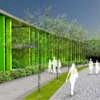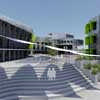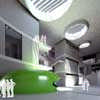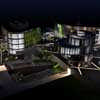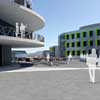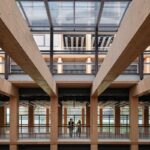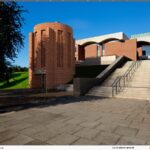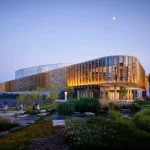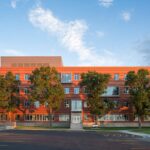University of Cyprus Campus Nicosia, Cypriot Building, Education Design, Architecture
University of Cyprus Campus in Nicosia
Cypriot Higher Education Building – design by BM3 Architecture
12 Oct 2011
University of Cyprus Campus Nicosia Building
Design: BM3 Architecture
Faculty of Engineering, University building of Cyprus
BM3 Architecture was recently placed for an International Competition for a new Faculty of Engineering at the University of Cyprus.
The brief for this project was to produce a sustainable master plan the new University Building in Cyprus with opportunity for future expansion. This involved designing several buildings that include a Structural & Earthquake engineering laboratory, Department of civil & environmental engineering, Deanery & Common space, Department of electrical & Computer engineering and Department of mechanical & manufacturing engineering.
To achieve these objectives of the brief it was decided that the departments MME, ECE and CEE should focus on a communal central space which will contain the Deanery, Common Use Spaces and Department of Architecture Spaces at the heart of The Faculty. The main entrances to each department will be from this central space. Users will converge in this space encouraging interaction and creating a focal point for all departments. Secondary entrances from the east and the west will create links with the rest of the campus. An open space at the centre of the site allows for good air movement and daylight penetration as well as opening up views of the Aronas Mountain and the Athalassa Forest. The circulation spaces in the square between departments are complemented by outdoor teaching and social spaces.
It was decided that the CEE building would sit to the south of the site next to the road due the frequent deliveries of materials to the larger laboratories. This building is surrounded by a ‘dry moat’ allowing light to the lower level.
The site layout encourages the interaction of students between departments through a central communal space. This concept is continued in the design of each of the department buildings. From the main entrance into each department you enter the department ‘hub’ illuminated by a north lit atrium. From this hub is access to the laboratory ‘wings’.
Having divided The Faculty into separate buildings it is vital that it still reads as a whole. The laboratory wings are generally single aspect and face north-south with the corridor on the south side. The external walls to the corridors are largely glazed, and therefore, naturally lit protected from solar gain by horizontal louvres. The labs are relatively shallow in plan allowing for good day lighting and natural ventilation when required. East and west elevations have horizontal and vertical shading to control a range of sun angles. The inclined elevations around The Faculty Square also help to enclose the space and connection between the department buildings. These principles have been adopted on each department for continuity tying the building together.
The Structural and Earthquake Engineering Laboratory is designed as a landmark building on the southern elevation denoting the gateway into the site. The cladding is positioned giving the appearance of ‘cracks’ synonymous with its function.
Similar materials have been used on each department building for unity. The elevations are largely glazed. This was a key objective avoiding the need for artificial lighting and providing good views out improving the working environment and views in adding to the activity of the spaces around The Faculty. Other main facing materials are a fractal patterned aluminium cladding and fair faced concrete. The aluminium will have a matt finish avoiding glare issues.
This cladding with the fractal pattern gives the building a machine like, ‘high tech’, aesthetic appropriate for this type of building. The main building structure is concrete due to its thermal properties and is expressed as a facing material where appropriate.
Aluminium louvers and canopies around the windows help articulate the elevation while moderating the natural environmental impact. The roofs are generally covered in a single ply membrane which can be easily formed to a curve where necessary.
Throughout The Faculty the colour green has been used. It has been a considered choice not just in its appropriate aesthetic qualities when set it the steel grey of the fare face concrete, but also in its mood enhancing properties. Being in the centre of the spectrum, it is the colour of balance .When the world about us contains plenty of green, this indicates the presence so we are reassured by green, on a primitive level. Green is associated with tranquillity and balance and also represents nature and harmony. This is the very essence of all pure engineering principle, where Man’s endeavour to create and solve should ultimately lead to balance and harmony.
Landscaping has been an important part of this master plan. A variety of external spaces have been created. The Faculty Square has a mix of larger open social spaces and tiered seating areas. External spaces have to be shaded to create a pleasant environment, and this is done not only by the placement of the buildings, and shading devices but also by the introduction of carefully selected trees.
Each building is designed to deal with the high summer temperatures and sunlight using sustainable solutions. Focus was given on the Orientation of the buildings on the site to ensure that solar gains can easily be controlled. Thermal mass has been introduced into the buildings fabric by exposing the concrete soffit. This will regulate internal temperatures and dampen and delay variations in outdoor air temperature.
Careful consideration has been given to controlling solar gains. The facades facing south have a simple horizontal louvre to control mid-season and summer solar heat gains. The facades facing north make maximum use the north light using large windows and through good design need for artificial lighting has been minimised.
To reduce energy consumption, the aquifer beneath the site will be used for heating and cooling. The groundwater, typically at 18°C, will be used directly for cooling in the building without the need for an electric chiller for the majority of the year. 140m2 of photovoltaic’s (PV) will be integrated into the buildings roofs. The PV will power the aquifer pumping system and all general mechanical ventilation fans. Solar thermal panels will be located on the roof to provide at least 50% of the annual energy to heat the domestic how water for the buildings.
BM3 Architecture has successfully achieved a University Building that sits harmoniously within its surroundings, reacting and working with its environment, but also, in creating a building that inspirers and compliments its users with elegant but practical, well-formed spaces.
University of Cyprus Campus – Building Information
Title: Faculty of Engineering, University building of Cyprus
Architects: BM3 Architecture
Client: University of Cyprus
Cost: €45 Million
University of Cyprus Campus in Nicosia images / information from BM3 Architecture
Location: Nicosia, Cyprus
Cyprus Architecture
Cypriot Architecture Design – chronological list
Cypriot Buildings
Lemesos Office, Limassol
Skinotechniki – George Papadopoulos

image from architect
Lemesos Office
Polytia Architects
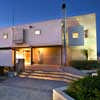
image from architect
Nicosia Residence
Lemesos House
Skinotechniki – George Papadopoulos
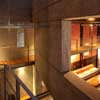
photo : Andy Soteriou / Christos Papantoniou
Lemesos House
Developments in countries close to Cyprus
Comments / photos for the University of Cyprus Campus – Nicosia Higher Education Architecture page welcome
Website: University of Cyprus in Nicosia.

